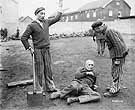
|
|
|

|

|

|

|
|
Click on an image to see a larger, more detailed picture.
|
|
|
|
|
| 1945: Liberation and Rebuilding |

|
pg. 579 |

|
|
|
|
| |
|
|
|
|
|
|
| |
Neither
Adolf Hitler nor Franklin Roosevelt lived to see the end of World War II and the Holocaust. On May 7, 1945, at Rheims, France, General Alfred Jodl signed Nazi Germany's unconditional surrender. One week earlier, on April 30, the Führer and Eva Braun--whom Hitler had married the night before--committed suicide in his Berlin bunker. On April 12, less than three weeks before Hitler's death, a brain hemorrhage had taken the American president's life. The Nazis had begun evacuating Jewish prisoners from Auschwitz on January 17, partly to cover evidence of the "Final Solution," partly to preserve slave labor, and also to prolong the policies of mass death. Without food or shelter during the bitter winter, some 60,000 Jews were force-marched toward concentration camps in the German interior. The death rates were immense. Once the prisoners reached camps such as Buchenwald or Bergen-Belsen, hopeless conditions awaited them. While advancing Soviet forces reached Nazi camps in Eastern Europe--including Stutthof, Gross-Rosen, and Sachsenhausen--American and British troops came upon other concentration camps. On April 4, 1945, Ohrdruf, a Buchenwald satellite, became the first camp liberated by American troops. On April 12, the day that President Roosevelt died, American Generals Omar Bradley, George Patton, and Dwight Eisenhower saw Ohrdruf themselves. Eisenhower wrote that the scenes of brutality and starvation "beggar description." Ohrdruf was not the worst of the Nazi camps. American and British liberators encountered greater devastation on April 9 at Dora-Mittelbau and its satellite camps, where thousands of prisoners had slaved in unbearable underground conditions to manufacture V-2 missiles. On April 11 American forces freed Buchenwald. One of the oldest concentration camps in the Nazi system, it held more than 238,000 prisoners during its eight-year existence, 43,000 of whom died or were killed. Four days later British troops liberated Bergen-Belsen, where they found 13,000 corpses and 58,000 prisoners--mostly Jews--still alive but in critical condition. Unable to recover from the abuse they had received, about 10,000 inmates perished in the next few weeks. On May 5 American troops reached the Mauthausen concentration camp in Austria. Operational for seven years, Mauthausen had contained a total of nearly 200,000 prisoners. Few were alive at Mauthausen at liberation. The camp's death toll was 119,000. On May 8 the Allies celebrated V-E Day (Victory in Europe Day)--the war in Europe was officially over. That same day, Soviet troops liberated the camp/ghetto at Theresienstadt, Czechoslovakia, and found 19,000 prisoners alive. Another 121,000 had died
|

|

|

|

|
|

Two liberated Dachau prisoners stand over a camp guard named Weiss, who is reduced to helplessness without his weapons of punishment.
Photo: U.S. Army Signal Corps/National Archives
|
|
|
|
|
| 1945: Liberation and Rebuilding |

|
pg. 579 |

|
|
The Holocaust Chronicle
© 2009 Publications International, Ltd.
|
|
